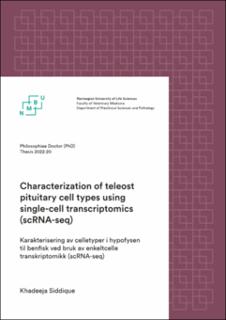| dc.description.abstract | The pituitary gland is an endocrine gland found in vertebrates. It produces and secretes a variety of essential peptide hormones which regulate several physiological functions, such as reproduction, growth, metabolism, homeostasis, and response to stress. It is thought that each hormone is synthesized by a different cell type in teleost fish. The regulation of hormone production and release is complex, involving signals from the hypothalamus, paracrine control by other pituitary cell types, and feedback from downstream target organs. For a complete picture of the regulation of any one peptide hormone, it is therefore important to include the physiological state of many different cell types, as well as their relative positions and contacts. In this study, I have used single-cell transcriptomics (scRNA-seq) and imaging techniques to generate large data sets on gene expression, cell types, and their spatial organization in the pituitary gland of the model fish medaka. I have used these to resolve several open questions in teleost pituitary biology.
First, I used scRNA-seq to profile gene expression in thousands of individual cells from adult medaka. Clustering of these data reveals the female and male pituitary glands to be composed of 15 and 16 distinct cell types, respectively. Ten of these are associated with the production of peptide hormones, showing a clear division of cellular labour: each hormone is produced by a single dedicated cell type, with a few exceptions.
Next, I studied the localization of seven of these cell types within the pituitary. Using in situ hybridization with fluorescent probes (FISH) for hormone-encoding genes, we constructed a three-dimensional atlas of the medaka anterior pituitary. The 3D distribution of the cells expressing the hormone-encoding genes pomca, lhb and tshba in adult animals shows evidence of sexual dimorphism. Based on both FISH and scRNA-seq, I identified a few bi-hormonal cells co-expressing fshb–tshba, lhb–sl, and lhb–fshb. However, there is no evidence for a multihormonal population such as the one found in mammals.
In the last paper, I characterize two cellular populations expressing prl (encoding the hormone prolactin, which is involved in osmoregulation, among other functions). Based on the scRNA- seq data, these lactotrope populations are clearly distinct, with one are indistinguishable at the transcriptomic level and consist of both types of lactotropes. In summary, these new data firmly support the ‘one cell type – one hormone’ hypothesis of the teleost pituitary. In addition, they form a starting point for new discoveries and hypotheses, as demonstrated by the unexpected finding of lactotrope heterogeneity. In the future, they should provide a rich resource for comparative and functional studies on the teleost pituitary gland. similar in expression profile to cells expressing either growth hormone or somatolactin, and the other more similar to stem- cell-like populations. In situ hybridization (in other fish species) previously revealed several spatially separated prl-expressing clusters: one major cell cluster in the most anterior part of the pituitary, and sometimes additional smaller patches of cells. Under the hypothesis that such lesser patches represent developmentally (and possibly functionally) distinct cell populations, we, therefore, set out to demonstrate their equivalence to the transcriptomically defined stem cell-like lactotropes. However, to our surprise, the major cluster and minor patches are indistinguishable at the transcriptomic level and consist of both types of lactotropes.
In summary, these new data firmly support the ‘one cell type – one hormone’ hypothesis of the teleost pituitary. In addition, they form a starting point for new discoveries and hypotheses, as demonstrated by the unexpected finding of lactotrope heterogeneity. In the future, they should provide a rich resource for comparative and functional studies on the teleost pituitary gland. | en_US |

